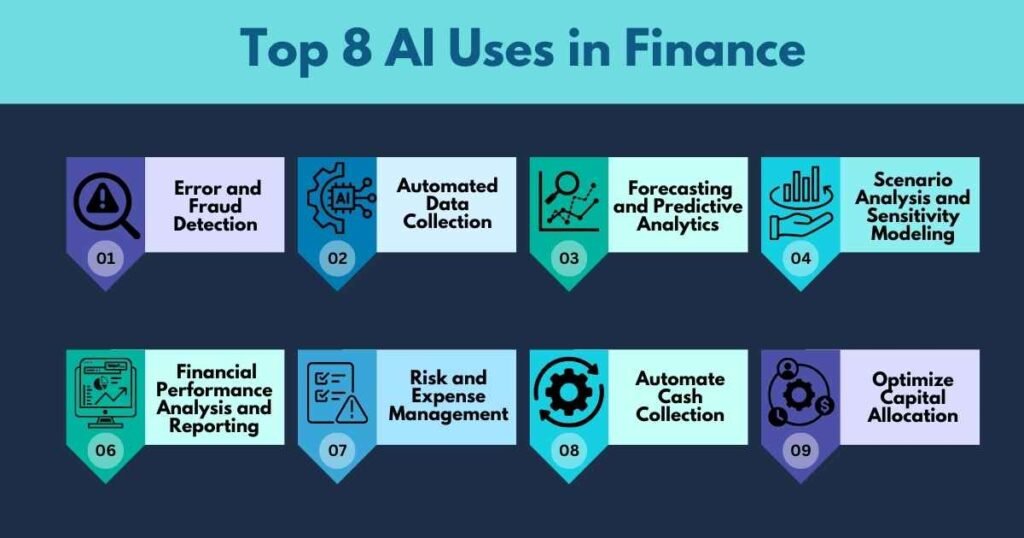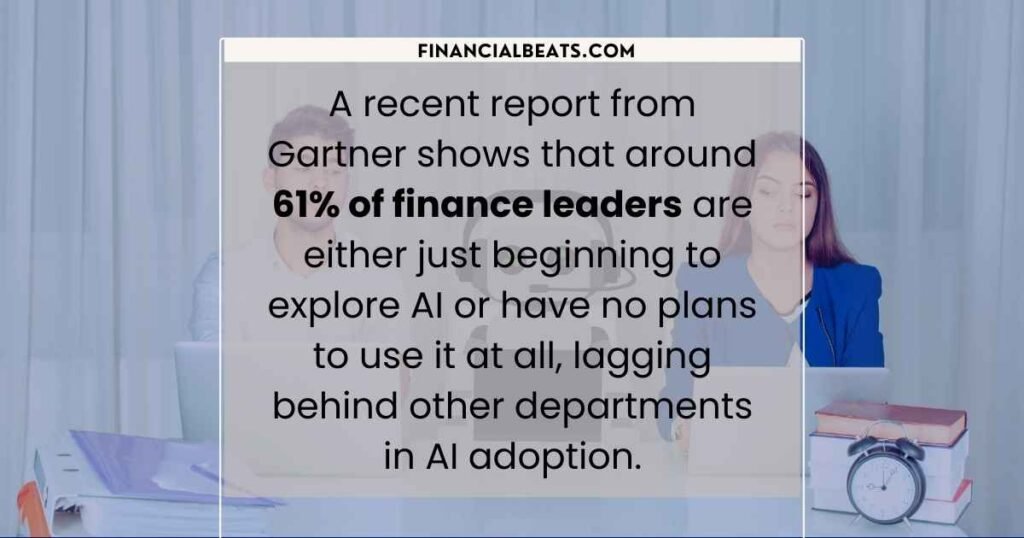Steve Jobs once said, “Innovation separates a leader from a follower.” In finance, adopting AI is becoming a key way for businesses to stay ahead. Using AI in financial planning and analysis (FP&A) is like switching from a paper map to GPS—suddenly, the path is clearer, faster, and more efficient.
FP&A leaders know that AI isn’t just a buzzword; it’s a powerful tool for better decision-making, smoother processes, and finding insights that old methods might miss.
Why Should FP&A Leaders Consider Using AI?
FP&A leaders gain major benefits by adopting AI, from better accuracy to a stronger competitive edge. Integrating AI into FP&A brings several positive outcomes:
- AI quickly processes large amounts of financial data, reducing errors and improving data reliability.
- It enables advanced analytics and provides valuable insights through predictive modeling and scenario analysis.
- AI tools offer real-time data access, helping FP&A leaders make quicker, more informed decisions.
Top 8 AI Uses in Finance

AI and machine learning can improve financial planning and analysis in various ways. Here are some common examples:
1. Error and Fraud Detection
Making sure financial data is accurate is important for FP&A professionals. Smart machine learning (ML) tools help spot errors, unusual patterns, and inconsistencies in financial data, reducing the risk of missing issues that might slip by during manual checks.
Advanced AI solutions provide real-time analysis while data is being entered. These tools monitor and check the data as it’s inputted, acting as a safeguard against errors entering the system. This helps maintain data accuracy and saves time and money that would be spent fixing mistakes later.
For example, Bank of America uses AI to monitor transactions and detect fraud. By analyzing data like payment history and IP addresses, the bank can quickly catch suspicious activity. Their AI-driven system has reportedly saved them over a billion dollars in potential fraud losses.
2. Automated Data Collection
One of the most valued AI features is automating data gathering for FP&A teams. Instead of manually pulling data from various systems, databases, and spreadsheets, AI handles this automatically. This makes it easier for FP&A leaders to access accurate and up-to-date information, saving time and ensuring data is correct.
AI streamlines the process, allowing FP&A professionals to quickly get reliable data, boosting efficiency and accuracy in decision-making.
3. Forecasting and Predictive Analytics
AI uses its advanced analysis to review past financial data, market trends, and economic signals. It then provides accurate predictions and builds reliable models to forecast a company’s financial performance.
AI can also spot patterns and trends that people might miss, giving insights that go beyond human intuition.
With these accurate forecasts and AI-driven insights, leaders in financial planning and analysis (FP&A) can:
- Make data-based decisions
- Set realistic financial goals
- Adjust resource allocation
- Evaluate investment opportunities
4. Scenario Analysis and Sensitivity Modeling
AI-powered tools help FP&A leaders analyze different scenarios and test sensitivity. Adjusting variables, assumptions, and market conditions, these tools quickly generate multiple scenarios to show how they impact financial outcomes. This ability helps in evaluating strategic options and understanding their financial effects, leading to smarter decisions.
5. Financial Performance Analysis and Reporting
AI-powered tools help FP&A leaders analyze and report financial performance more effectively. These tools can process large amounts of financial data, highlight key performance indicators (KPIs), and create interactive dashboards and reports. With these insights, FP&A leaders can track performance, spot trends, and share financial results with stakeholders more clearly.
6. Risk and Expense Management
AI tools for risk management allow FP&A leaders to assess and handle risks more effectively. These tools analyze factors like market shifts, regulations, and credit risks to identify potential threats to financial performance. With this information, FP&A leaders can:
- Develop risk-reduction strategies
- Test financial models under different scenarios
- Strengthen the resilience of their financial plans
AI also improves expense management by making reporting and analysis simpler. Machine learning models can study expense data, detect patterns, and offer insights to help FP&A leaders improve their expense management practices. Using AI, they can find ways to cut costs, reduce wasteful spending, and boost the financial health of their organization.
7. Automate Cash Collection
Machine learning models predict when customers are likely to pay their invoices. This helps collection teams take action early to collect payments before they become overdue. The predictions help focus efforts on accounts that are at risk, making collections more efficient. These forecasts also contribute to AI-driven cash flow projections, giving valuable insights for better cash flow management.
8. Optimize Capital Allocation
AI algorithms help FP&A leaders decide where to invest money more wisely. They consider factors like return on investment, risk, cash flow forecasts, and strategic goals to determine the best way to allocate financial resources across projects, business units, or investments. This helps FP&A leaders make informed decisions that maximize profits and drive financial success.
Overcoming Skepticism of AI and Finding Ways to Improve

Even though AI has advanced in financial planning and analysis (FP&A), many companies are still hesitant to use it. A recent report from Gartner shows that around 61% of finance leaders are either just beginning to explore AI or have no plans to use it at all, lagging behind other departments in AI adoption.
Finance leaders, often cautious, might be taking their time to understand how AI tools work and see how other departments are using them before applying them in their own processes.
Marco Steecker, a senior leader at Gartner, mentioned that despite AI’s potential, most finance teams have very limited AI usage. He advises CFOs to work closely with their teams to compare their progress with industry peers and learn from early adopters to speed up their AI adoption.
Gartner highlights four main reasons for the delay in using AI in finance: lack of technical skills, poor data quality, limited practical use cases, and competing priorities.
AI Opens Doors, But Human Insight Guides
The rapid growth of data and easier access to AI tools have opened up big opportunities to change FP&A. With major investments like PWC’s $1 billion into Generative AI, it’s clear that AI is reshaping how businesses make decisions and achieve results. However, while AI can analyze data and find patterns, it’s most powerful when paired with human expertise and judgment.
AI is like a strong engine, but without a skilled driver, it won’t reach its full potential. The real question isn’t just if you’re using AI, but how you’re blending it with human insight. Are you really using AI to create valuable insights and make better decisions, or are you just following the trend to fit in?
FAQs
How can AI be used in FP&A?
AI uses in finance include automating data analysis, predicting trends, forecasting revenue, and spotting risks. It can also improve budgeting by quickly processing large amounts of data and identifying patterns that humans might miss.
What are the use cases for generative AI in FP&A?
Generative AI uses in finance include creating reports, generating financial insights, and simulating different financial scenarios. It can also help automate the creation of presentations or narratives from financial data, making it easier to communicate insights.
Which AI tool is best for financial analysis?
Tools like IBM Watson, Microsoft Power BI, and Oracle AI are popular AI uses in finance for financial analysis. These tools offer features like predictive analytics, automated reporting, and data visualization that provide deep financial insights.
What type of AI is used in finance?
In finance, AI types like machine learning, predictive analytics, and natural language processing (NLP) are commonly used. Machine learning helps with forecasting and risk analysis, while NLP is useful for analyzing text data like financial reports.
